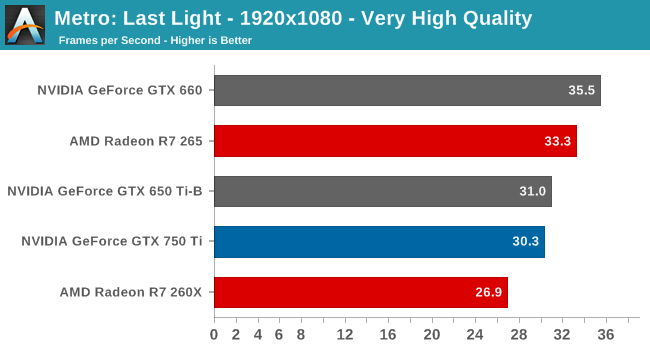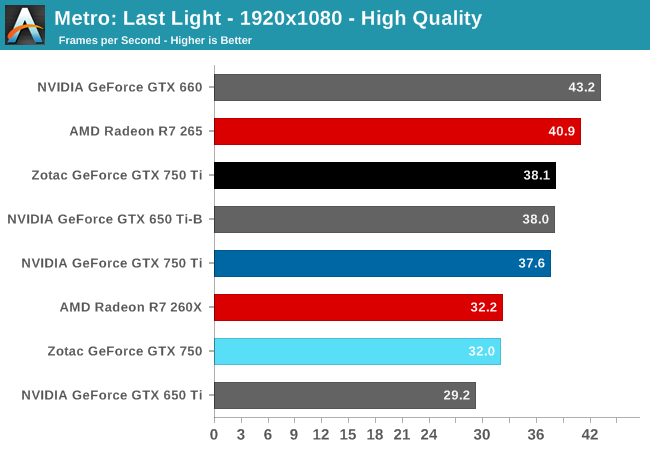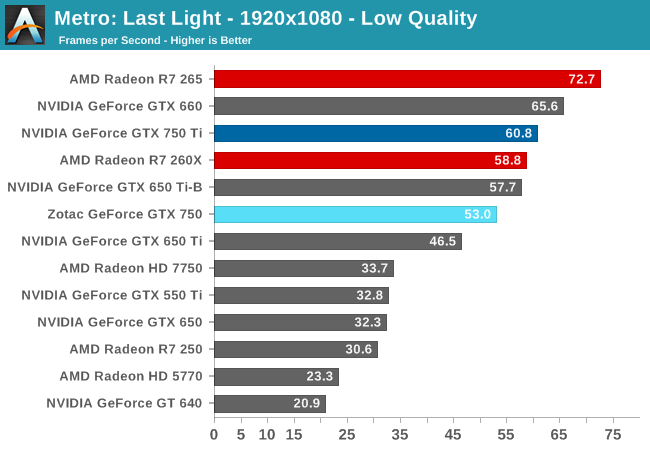The NVIDIA GeForce GTX 750 Ti and GTX 750 Review: Maxwell Makes Its Move
by Ryan Smith & Ganesh T S on February 18, 2014 9:00 AM ESTMetro: Last Light
As always, kicking off our look at performance is 4A Games’ latest entry in their Metro series of subterranean shooters, Metro: Last Light. The original Metro: 2033 was a graphically punishing game for its time and Metro: Last Light is in its own right too. On the other hand it scales well with resolution and quality settings, so it’s still playable on lower end hardware.



Diving into our performance analysis, we’ll be looking at a few different factors. On a competitive basis, the GTX 660 and the R7 265 are the GTX 750 Ti’s closest competitors. Though we’ll also want to compare it to GTX 650, so see what a GK107 versus GM107 matchup looks like. Meanwhile the GTX 750’s closest competitors will be the R7 260X, and to a lesser degree the GTX 650 Ti.
Being one of our more difficult games, Metro shows right off the bat that these mainstream video cards, no matter how fast they are, will face a difficult time. The GTX 750 Ti can stay comfortably above the 30fps at high quality, but the GTX 750 not so much.
What’s clear right off the bat two is two things. The first is that GTX 750 Ti, the GM107 flagship, is significantly faster than GTX 650, the GK107 flagship. GTX 750 Ti is just short of doubling GTX 650’s performance in this benchmark.
The second point is that neither GTX 750 series card is going to fare well against its AMD counterpart. Both the R7 265 and R7 260 are faster than the GeForce cards, and by over 10% at times.
Finally, GTX 750 Ti won’t be touching GTX 660 here. It’s close, but especially at higher quality settings the GTX 660 is pulling away. GTX 750 Ti can’t completely make up for the lack of memory bandwidth and ROP throughput.










177 Comments
View All Comments
Mondozai - Wednesday, February 19, 2014 - link
Wait for 800 series budget cards if you have the patience. Hopefully no more than 4-5 months if TSMC does very well on 20.Jeffrey Bosboom - Wednesday, February 19, 2014 - link
I understand the absolute hashrate on these cards will be low, but I'm interested to know how the focus on power consumption improves mining performance per watt. (Though I can't imagine this lowish-end cards would be used, even if efficient, due to the fixed cost of motherboards to put them in.)Antronman - Wednesday, February 19, 2014 - link
Nvidia's best cards have tiny hash rates compared to 95% of every AMD GPU ever released.JarredWalton - Wednesday, February 19, 2014 - link
Apparently you're not up to speed on the latest developments. GTX 780 Ti as an example is now hitting about 700 KHash in scrypt, and word is the GTX 750 will be pretty competitive with 250-260 KHash at stock and much lower power consumption. Some people have actually put real effort into optimizing CUDAminer now, so while AMD still has an advantage, it's not nearly as large as it used to be. You could even make the argument that based on perf/watt in mining, some of NVIDIA's cards might even match AMD's top GPUs.darthrevan13 - Wednesday, February 19, 2014 - link
Why did they chose to retire 650 Ti Boost and replace it with 750Ti? 650 Ti B is a much better card for high end games because of the memory interface. They should have marketed 750Ti as 750 and 750 as 740.And why on earth did they not include full support for HEVEC and DX11.2? You're limiting the industry's adoption for years to come because of you're move. I hope they will fix this in the next generation 800 cards or when they will transition to 20nm.
Ryan Smith - Thursday, February 20, 2014 - link
Not speaking for NV here, but keep in mind that 650 Ti Boost is a cut-down GK106 chip. All things considered, 750 Ti will be significantly cheaper to produce for similar performance.NVIDIA really only needed it to counter Bonaire, and now that they have GM107 that's no longer the case.
FXi - Wednesday, February 19, 2014 - link
No DX 11.2 or even 11.1 support? For THAT price??Pass...
rish95 - Wednesday, February 19, 2014 - link
According to GeForce.com it supports 11.2. Not sure what's up with this:http://www.geforce.com/hardware/desktop-gpus/gefor...
willis936 - Wednesday, February 19, 2014 - link
You don't need to be compliant to support something. Compliance means you meet all required criteria. Support means you can run it without having necessarily all the bells and whistles. If console hardware has DX compliance then the devs will take advantage of that and when they're ported you'll lose some of the neat graphics tricks. They might still be able to be done in software, you'll just need a bigger GPU to get the same frame rates :p Some things might not be able to be done in software though. Idk enough about DX to say.sourav - Wednesday, February 19, 2014 - link
does it will support on a pci v2?